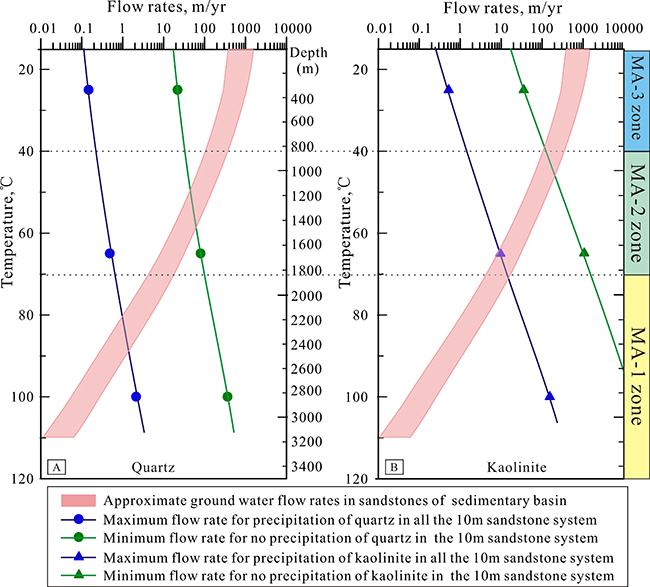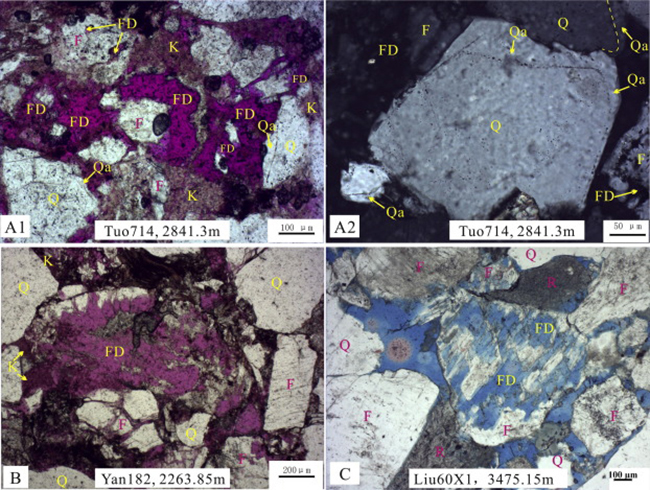Recently, the group led by prof. Cao Yingchang from School of Geoscience made new progress on the research of water-rock interaction. The paper Reactive transport modeling of coupled feldspar dissolution and secondary mineral precipitation and its implication for diagenetic interaction in sandstones was released by Geochimica et Cosmochimica Acta. The first author was postdoctor Yuan Guanghui.
Dissolution of feldspars and precipitation of secondary minerals (kaolinite, illite and quartz) are significant diagenetic processes in arkosic sandstones. The group examined moderately buried sandstones in the Eocene Shahejie Formation from two sags in the Bohai Bay Basin, East China. In the paper, three different types of mineral assemblages (MA) were identified: extensively leached feldspars with a large amount of authigenic kaolinite and quartz cement (MA-1), extensively leached feldspars with a large amount of authigenic kaolinite and minor quartz cement (MA-2), and extensively leached feldspars with a small amount of both authigenic kaolinite and quartz cement (MA-3). Modeling results suggest that a dissolution zone, a transitional zone, and a precipitation zone can be formed in a sandstone unit with suitable constraints of temperature, flow rate, fluid composition and mineral reaction rate.


Comparisons between modeling results and observations of natural sandstone diagenesis suggest that an MA-1 assemblage is likely to occur in buried sandstones at high temperatures (>70–80 °C) and low flow rates. An MA-2 assemblage may occur in moderately buried sandstones at moderate temperatures (40–70 °C), in deeply buried sandstones with faults and fractures serving as conduits of meteoric freshwater, or in shallow sandstones where meteoric water is not abundant. An MA-3 assemblage tends to occur in shallow sandstones at low temperatures (<40 –50 °c) and high flow rates, or in buried sandstones where faults and fractures develop widely and serve as freshwater conduits.
Dr. Carl Steefel, the deputy editor of Geochimica et Cosmochimica Acta and other peer review experts spoke highly of the research finding. These proposals are valid in natural arkosic sandstones and of great significance in deciphering the diagenetic environments where the feldspar dissolution and secondary mineral precipitation have occurred.
In the past five year, with the support of national funds, prof. Cao Yingchang's group has conducted a number of studies on research of oil and gas basin diagenesis and has produced a series of research achievements with more than 40 papers published on Geochimica et Cosmochimica Acta, AAPG Bulletin, Marine and Petroleum Geology, Sedimentary Geology. Postdoctor Yuan Guanghui has pulished 20 papers on Geochimica et Cosmochimica Acta、AAPG Bulletin、Marine and Petroleum Geology、Petroleum Science.
Geochimica et Cosmochimica Acta(GCA) is a biweekly peer-reviewed scientific journal published
by Elsevier. It covers all aspects of terrestrial geochemistry, meteoritics, and planetary geochemistry.
See more about the research:http://www.sciencedirect.com/science/article/pii/S0016703717301734
Editor: Bu Lingduo
Surce: UPC News Center
Updatetime: 2017-4-21